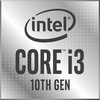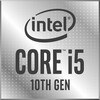Intel Core i3-1000G1 vs Intel Core i5-1030G7
Intel Core i3-1000G1
► remove from comparison
The Intel Core i3-1000G1 is a power efficient dual-core SoC for laptops and Ultrabooks based on the Ice -Lake-U generation that was announced in Mai 2019 (Computex). It integrates two Sunnycove processor cores (4 threads thanks to HyperThreading) clocked at 1.1 (base) - 3.2 GHz (single and dual core Turbo). According to Intel the Sunnycove cores achieve 18% more IPCs (Instructions per Clock).
The biggest improvement for Ice-Lake is the integrated Gen 11 architecture graphics adapter called UHD Graphics G1. The Core i3-1000G1 integrates the smallest GPU, the UHD Graphics that features 32 of the 64 CUs and clocks at 300 - 900 MHz. The faster variants offer higher clock speeds (up to 1100 MHz) and include Iris Plus G4 (e.g. in the similar named Core i3-1000G4) and G7.
Other improvements for Ice Lake are the AI hardware acceleration and the partial integration of Thunderbolt and WiFi 6 in the chip. The integrated DDR4 memory controller supports modules with up to 3200 MHz (and LPDDDR4 3733).
Performance
We have not tested a single system built around the 1000G1 as of August 2023. Expect the chip to be at least as fast as the Pentium 6500Y (two Amber Lakes cores, 4 threads, up to 3.4 GHz). In other words, not fast at all.
Power consumption
This Core i3 has a default TDP (also known as the long-term power limit) of 9 W, a value that laptop manufacturers are allowed to reduce just slightly to 8 W resulting in lower clock speeds and lower performance. TDP values that low are typical for affordable laptops, tablets and mini-PCs, mostly with no active cooling solution.
The processor is built with Intel's 2nd generation 10 nm process for decent, as of late 2022, energy efficiency.
Intel Core i5-1030G7
► remove from comparison
The Intel Core i5-1030G7 is a power efficient quad-core SoC for laptops and Ultrabooks based on the Ice -Lake-Y generation that was announced in Mai 2019 (Computex). It integrates four Sunnycove processor cores (8 threads thanks to HyperThreading) clocked at 0.8 (base) - 3.8 (single core Turbo) GHz. All four cores can turbo up to 3.2 GHz using Turbo Boost. According to Intel the Sunnycove cores achieve 18% more IPCs (Instructions per Clock).
The biggest improvement for Ice-Lake is the integrated Gen 11 graphics card called Iris Plus Graphics. The Core i5-1030G7 integrates the biggest G7 variant with 64 CUs clocked at 300 - 1050 MHz. The Iris Plus G7 should be twice as fast as the predecessors and best the AMD Vega 10 GPU in current Ryzen APUs. However, in the Y-series the gaming performance will be again depending on the cooling solution and may degrade clearly over time (compared to the Core i7-1065G7 with 15 - 25 Watt e.g.).
Other improvements for Ice Lake are the AI hardware acceleration and the partial integration of Thunderbolt and WiFi 6 in the chip. The integrated DDR4 memory controller supports modules with up to 3200 MHz (and LPDDDR4 3733).
Performance
While we have not tested a single system built around the 1030G7 as of August 2023, it's safe to expect the chip to be about half as fast as the Core i5-1035G7, as far as multi-thread performance is concerned. Which is fairly poor as of mid 2023.
Your mileage may vary depending on how high the CPU power limits are and how competent the cooling solution of your system is.
Power consumption
This Core i5 has a default TDP (also known as the long-term power limit) of 9 W, a value that laptop manufacturers are allowed to increase just slightly (12 W being the upper limit) resulting in higher clock speeds and higher performance. The processor is built with Intel's 1st gen 10 nm process for OK, as of late 2022, energy efficiency.
| Model | Intel Core i3-1000G1 | Intel Core i5-1030G7 | ||||||||||||||||||||||||||||||||
| Series | Intel Ice Lake | Intel Ice Lake | ||||||||||||||||||||||||||||||||
| Codename | Ice Lake-Y | Ice Lake-Y | ||||||||||||||||||||||||||||||||
| Series: Ice Lake Ice Lake-Y |
|
| ||||||||||||||||||||||||||||||||
| Clock | 1100 - 3200 MHz | 800 - 3500 MHz | ||||||||||||||||||||||||||||||||
| L2 Cache | 1 MB | 2 MB | ||||||||||||||||||||||||||||||||
| L3 Cache | 4 MB | 6 MB | ||||||||||||||||||||||||||||||||
| Cores / Threads | 2 / 4 | 4 / 8 | ||||||||||||||||||||||||||||||||
| TDP | 9 Watt | 9 Watt | ||||||||||||||||||||||||||||||||
| Technology | 10 nm | 10 nm | ||||||||||||||||||||||||||||||||
| max. Temp. | 100 °C | 100 °C | ||||||||||||||||||||||||||||||||
| Features | LPDDR4-3733 RAM, PCIe 3, 4 GT/s bus, DL Boost, GNA, MMX, SSE, SSE2, SSE3, SSSE3, SSE4.1, SSE4.2, AVX, AVX2, AVX-512, BMI2, ABM, FMA, ADX, VMX, SMEP, SMAP, EIST, TM1, TM2, HT, Turbo, SST, AES-NI, RDRAND, RDSEED, SHA, SGX | LPDDR4-3733 RAM, PCIe 3, 4 GT/s bus, DL Boost, GNA, MMX, SSE, SSE2, SSE3, SSSE3, SSE4.1, SSE4.2, AVX, AVX2, AVX-512, BMI2, ABM, FMA, ADX, VMX, SMEP, SMAP, EIST, TM1, TM2, HT, Turbo, SST, AES-NI, RDRAND, RDSEED, SHA, SGX | ||||||||||||||||||||||||||||||||
| iGPU | Intel UHD Graphics G1 (Ice Lake 32 EU) (300 - 900 MHz) | Intel Iris Plus Graphics G7 (Ice Lake 64 EU) (300 - 1050 MHz) | ||||||||||||||||||||||||||||||||
| Architecture | x86 | x86 | ||||||||||||||||||||||||||||||||
| Announced | ||||||||||||||||||||||||||||||||||
| Manufacturer | ark.intel.com | ark.intel.com | ||||||||||||||||||||||||||||||||
| L1 Cache | 192 KB |
Benchmarks
* Smaller numbers mean a higher performance
1 This benchmark is not used for the average calculation


 Deutsch
Deutsch English
English Español
Español Français
Français Italiano
Italiano Nederlands
Nederlands Polski
Polski Português
Português Русский
Русский Türkçe
Türkçe Svenska
Svenska Chinese
Chinese Magyar
Magyar